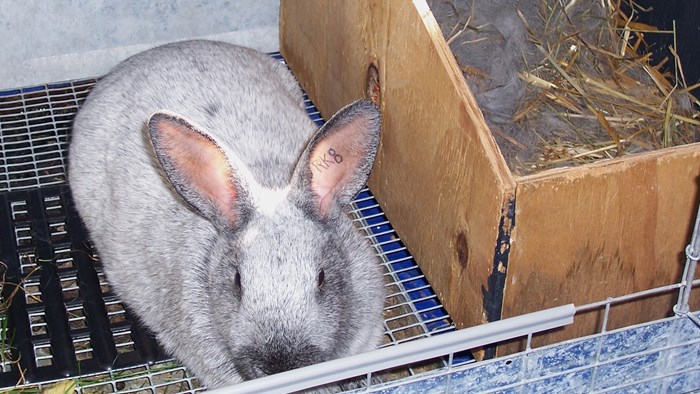
Unfortunately, rabbits don’t always “breed like rabbits”. There’s a bit of a learning curve when it comes to breeding meat rabbits.
Don’t be discouraged if your doe doesn’t get pregnant or you lose a litter of kits… it’s all part of the learning process. It usually takes a few attempts to successfully raise litters of robust kits. Follow the guidelines below for the best chance of success!
Should You Breed Rabbits?
Breeding rabbits is not something to be entered into lightly. Be sure you’ve read our Quick Start Guide and have a plan to deal with all of the offspring.
If you’re breeding for meat, great, but make sure you can butcher a rabbit first – so you won’t chicken out when it’s time to harvest the kits. If you don’t want to butcher rabbits yourself, find a local processor or fellow meat rabbit raiser who’s willing to do the job before beginning any breeding attempts.
Think you’ll sell the extra babies as pets, think again. There are already thousands of bunnies in shelters looking for homes – please don’t add to the problem. Large breed rabbits make a lot of waste and aren’t the best choice for house pets. Most responsible meat rabbit breeders avoid selling to pet owners for that reason.
If you want to raise breeding or show stock, that’s great too. Invest in quality purebred rabbits with pedigrees and plan to cull all kits that don’t improve the breed. Inferior meat rabbits belong in the stew pot.
Breeding Meat Rabbits
Meat rabbits are old enough to breed at 5-6 months. They should be at least 80% of their adult weight (about 8 pounds). Does should have a small dewlap. Check that both testicles have descended on bucks.
Select unrelated rabbits with complimentary characteristics. For example, pair a doe with weak shoulders and nice hindquarter to a buck with great shoulders. Don’t breed two rabbits with the same fault or you’ll concentrate it in the offspring. The rabbits can have some common ancestry, but there should be plenty of differences as well. Do not breed siblings together.
Give rabbits a health check before breeding. Check their teeth (no malocclusion) and body condition. Stroke the rabbit’s back with your hand. You’ll feel rounded bumps of the spine if the rabbit is in good condition. If the spine feels sharp, the rabbit is thin. If you can’t feel the spine, the rabbit is fat.
Check the face and genitals of both rabbits to make sure there are no scabs which may indicate rabbit Syphilis. Both testicles should be descended on bucks. The doe is not likely to be receptive if her vulva is pale pink. If it’s dark pink or purple, she’s ready! Never breed rabbits with congenital faults or signs of disease.
Breeding Schedule
Breed does for the first time around 6 months and regularly after that to keep them productive. Ration pellets between litters to keep them slim and trim. Don’t bother trying to breed a virgin doe over a year old. Adult does pack fat around the reproductive organs which can make them infertile or cause problems with delivery.
Most homesteaders raise 4-5 litters a year per doe. Re-breed does 6 weeks after kindling for 5 litters a year or 8 weeks postpartum for 4 litters a year. If possible, breed two does at a time, so you can foster kits if needed. A single buck can service does on consecutive days. Breed one doe the first day, then breed the second doe the following day. You’ll need two nest boxes if you use this breeding plan.
In areas with harsh winters, don’t attempt to breed in winter unless your rabbits have very good shelter. Most rabbits are not interested in breeding in late fall/winter because the daylength is short. Put lights on for 12-14 hours a day for a week before trying to breed in the “off season.”
How to Breed Rabbits
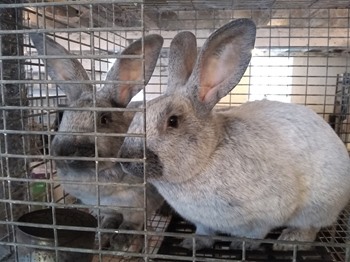
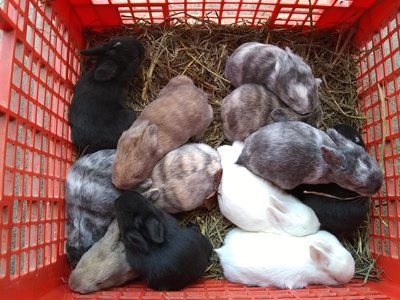

First, make sure you actually have a male and female. Rabbits are often sexed incorrectly. Occasionally, even a rabbit sexed by an experienced breeder turns out to be the opposite gender when it matures. Double check gender before attempting to breed rabbits for the first time.
Always bring the doe to the buck for breeding, not the other way around. Does are territorial and may attack a buck put in their space. Wear gloves and use a couple small towels to move rabbits. Put the doe in the buck’s cage. Close the door. Take a step back and stand right there and watch.
Never leave breeding rabbits unattended! Adult rabbits may fight and cause serious injury to each other. Angry does have been known to castrate bucks or make them unwilling to breed in the future.
The pair will usually circle a few times before the buck is able to mount. If the doe is receptive, she will lift her hindquarters when he mounts. You’ll see the buck fall off to the side if the breeding was successful. Watch for 2-3 fall-offs then remove the doe, using towels if necessary. Don’t leave the doe in too long or she may get upset.
If the doe is not receptive, she will frantically try to escape with her head in the air and tail down. If this is the case, remove her after a few minutes. Put a towel over the buck to distract him, then remove the doe from the cage with the other towel. Try again another day.
A successful “fall-off” – this is what you are looking for…
If you saw fall-offs, don’t try to re-breed the next day or the next week. If bred, the doe will be grumpy and may attack the buck. Does can also carry a second pregnancy which may result in aborting. If you wish to re-breed, do so 1 hour after the first breeding.
Get in the habit of recording the breeding, nest box, and due dates immediately after breeding. You will forget if you don’t write them down! Mark the breed date on the calendar. Then count down 4 weeks to mark the nest box date (day 28). Add a cage tag or calendar trigger to remind you to put in the nest box on day 28. The doe is due to kindle on day 31.
Or print a copy of our handy Rabbit Gestation Chart to easily calculate nest box & due dates. I keep it with my breeding board in the rabbitry.
To use: Find the breed date on the chart. Due date is immediately to the right of the breed date. Subtract 3 days for nest box date (day 28)
Example: If a rabbit is bred on April 9th, she will be due May 10th. Give her a nest box on May 7th.
Rabbit Pregnancy & Birth
Palpation
Commercial rabbit breeders often palpate their does at 10-14 days to verify pregnancy. Personally, I don’t palpate. The method is difficult to learn and seems kind of invasive. A lot of pressure must be put on the doe’s abdomen in an attempt to feel the developing kits. Just assume the doe is pregnant after a successful breeding and plan accordingly. If she doesn’t end up pregnant, rebreed at 40 days.
False pregnancy
Female rabbits can have false pregnancies. A doe may think she was bred if she was ridden by another rabbit or handled a lot around the hindquarters. In false pregnancy, does begin nesting and pulling fur 14 days after the stimulation. You can give her a nest box and some hay to do her thing. With false pregnancy, she will probably build a nest, then lose interest after a few days.
Give her a nest box in on day 28 is there’s any possibility she was bred. If she begins nesting at that point, she’s probably pregnant. If she uses it as a litter box, probably not.
Care of Pregnant Doe
Feed does their normal ration of pellets and hay throughout the pregnancy. Encourage exercise with balls or toys (like this). Fresh herbs and greens are a healthy addition to her diet. Raspberry leaf, fennel, parsley, oregano, lady’s mantle, dandelion, plantain, and clary sage offer nutritional support for pregnancy.
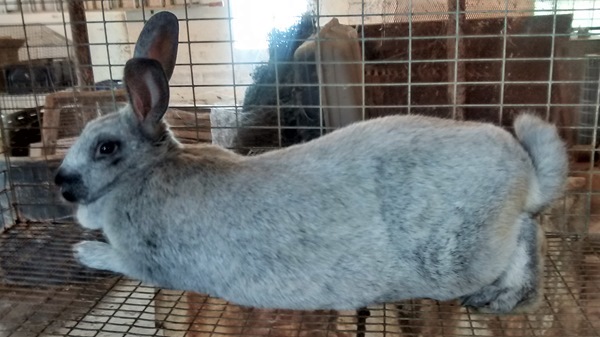
Minimum cage size for does is 2’x3’x18″H. A 30″x36″ or 2’x4′ cage is preferred for does with litters. If you need to move a doe to a new location to kindle, do so at least a week before her due date. That way she has plenty of time to settle into her new surroundings. Moving a doe right before or after kindling stresses her and can lead to complications.
Nest Box
A proper nest box is key to raising successful litters. Don’t try to use a cardboard box, bucket, or dish pan to save a few bucks. Make-shift nests result in lost litters and unfortunate “mishaps”. Rabbits will quickly destroy a box. If the sides are too low, nursing kits will get dragged out of the nest. Also, nest boxes must be heavy or wired to the side of the cage so they can’t flip it.
There are a number of nest box styles available– wood, metal, and wire. I prefer wooden boxes because they’re warmer in the winter and are easy to make from scrap wood or plywood. All sides must be at least 6″ high to scrape off nursing kits when mom exits the nest. If the front of your box is too low, attach a kit scraper board across the front (pictured below). Our nest boxes measure 10″H x 10″W x 18″L and have 1/2″ hardware cloth stapled to the bottom. They work great!
We built our nest boxes out of 1/2″ plywood using this design: Rabbit Nest Box Plans & Info
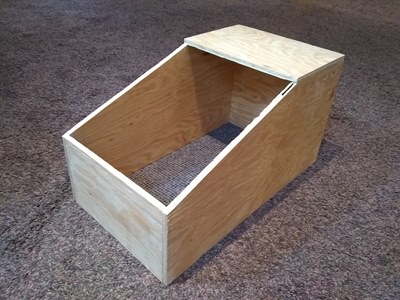

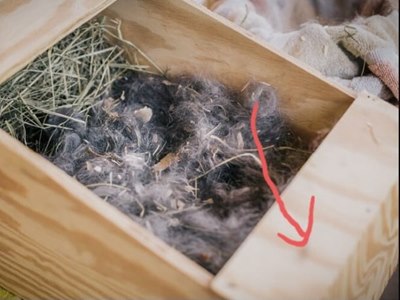
To Prep the Nest Box: Line the floor with cardboard or brown paper, add 1-2” of pine shavings (not cedar), and some hay or straw. I put a slotted resting mat above the cardboard before adding shavings to keep mom from digging out the cardboard.
Give pregnant does a nest box 28 days after breeding. Don’t put the nest box in too early, or does may get in the bad habit of lounging in the nest or use it as a bathroom. Take care not to put it in her potty corner.
I give first-time moms their nest on day 29 so they are less likely to soil the nest (since they don’t know what it’s for until they go into labor). Once she shows interest in the box and begins digging in it, add a big handful of straw or hay to the cage. If you put straw in before she’s accepted the box, she may try to build a nest outside the box. Expectant moms usually munch for a bit, then start gathering hay in their mouth to build a comfy “burrow” for their babies.
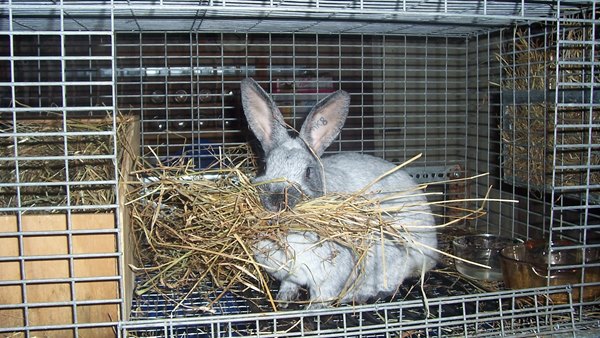
Good moms keep their nest clean. If the doe pees in the nest, remove soiled bedding and replace with fresh shavings. This happens occasionally with new moms before they understand what the box is for. If a doe repeatedly soils her nest after having litters, she may be a candidate for freezer camp. A few droppings in the nest are fine, but they should not be peeing in it.
Kindling
Does give birth about 31 days after breeding. Try not to disturb the expectant mom by hovering. Keep the area quiet and give her plenty of space. Check periodically during the day to see if she has delivered. Good moms will pull some fur before delivery (to line the nest) then pull more fur to cover the kits after birth. Rabbits usually have 6-9 kits per litter. If the doe hasn’t had kits by day 35, you can assume she isn’t pregnant and rebreed.
Once she has kindled, you need to clean the nest. Give mom a treat and remove the nest box from the cage. Carefully remove the kits to a towel-lined bowl. Count the babies and make sure they are warm. Remove bloody bedding, dead kits, and placentas from the nest. Make a depression in the back of the box (under the shelf). Fill it with clean fur and nestle the kits inside. Warm any chilled kits before returning them to the nest. Return the box to the cage.
Does sometimes give birth to kits on the wire instead of in the nest. Baby-saver wire or urine guards around the bottom 3″ of the cage will prevent newborn kits from crawling out of the cage. If this happens, warm up the kits and put them in the fur lined nest box. If mom didn’t pull any fur, you can pluck some from her belly or dewlap. Pregnancy hormones loosen the hair follicles so it’s easy to pull out. Save extra clean fur from brushing or overzealous does in a bag for occasions such as this.
Occasionally, you may find some cold lifeless kits. Newborn bunnies are not dead until they are “warm and dead”. Warm them up with body heat, a towel-lined heating pad, hot water bottle, or microwavable rice bag. Don’t use a heat lamp – it will cook the kits. In many cases, some bunnies will revive. However, if you see blood pooled in their nails after warming, they’re gone.
Common Rabbit Myth: “If you touch baby bunnies, mom will reject them.” While it’s best to leave wild bunnies alone, your rabbits know your scent and have no problem with their babies smelling like you. Just make sure your hands are clean and free of perfumed lotions or strong scents before touching kits. Don’t let strangers handle young kits.
The First Few Weeks
It’s perfectly normal for a doe to ignore her litter. Good moms do not lay in the nest. In the wild, does only visit the nest once or twice a day to nurse them. She spends the rest of her time elsewhere so she doesn’t draw predators.
Continue to feed mom her normal diet of pellets, hay, and forage. Nursing moms are allowed to eat all the pellets they want. Don’t feed treats the first week to minimize the chance of mastitis. Once kits open their eyes (10-14 days), you can feed 1-2 T. of treat mix (BOSS/rolled oats) a couple times a week to boost milk production. Small pieces of carrot, veggies, or fruit can also be fed. Avoid feeding parsley, sage, or mint to nursing does because it cuts their milk supply.
Once a day, put your hand into the nest box fur to feel for warmth. Check babies for smooth plump bellies the day after kindling. Weak, wrinkly kits aren’t being fed. If any kits are injured or slowly wasting away, click to learn how to humanely dispatch a baby rabbit. No one ever wants to put down a baby bunny, but sometimes it’s necessary to prevent suffering.
Clean the nest when kits are 2 weeks old. Remove bunnies and check to see that their eyes are open. Use a wet cotton ball to gently open any eyes that are sealed shut. Dump out all bedding and fur. Fill the nest with clean hay and replace the bunnies. Return the box to the cage and put a brick in front of the box, so adventurous kits can hop back in if they manage to get out. Remove the nest box at 3 weeks.
Baby rabbits are very unpredictable. They pop around like popcorn and will often pee on you when excited. Be very careful not to drop them when handling. If children want to hold a young bunny, have them sit on the ground and put it on their lap so it can’t be accidentally dropped.
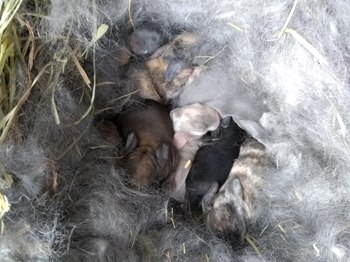

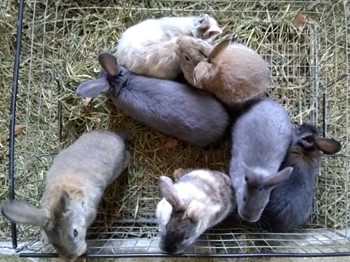
Baby bunnies can eat the same things mom eats, though they should not have fruits or veggies. Long grass, raspberry leaves, and plantain can be safely fed to young rabbits, especially if mom is already accustomed to eating them.
Weaning & Grow-out
We wean our kits at 6 weeks old. Move mom or the babies to a separate cage. I usually wean the whole litter at once, but you can leave a bunny with mom for another week if desired. Give newly weaned kits plenty of hay to prevent enteritis. Don’t feed mom any treats right after weaning because it will boost her milk supply, possibly leading to mastitis. Feed her rationed pellets, sage, parsley, and mint to help dry up her milk.
Our kits get weighed, sexed, and tattooed at 8 weeks. All the boys go in one cage and all the girls go in another. We keep them in those cages (sorted by gender) until sale or butcher. You can combine litters up to 9 weeks old with little to no fighting. Don’t try to combine older litters or they will fight.
Male and female kits must be separated by 12 weeks. Since most people have limited cage space or don’t want to bother sexing kits, they butcher at 12 weeks. Another option is to butcher all the bucks at 12 weeks, then butcher the does at 16 weeks for more meat. Pelts from 16 week old rabbits can be saved for tanning.
Rabbits become territorial as they reach sexual maturity. Any rabbits kept for breeding should given their own cage by 4 months old.
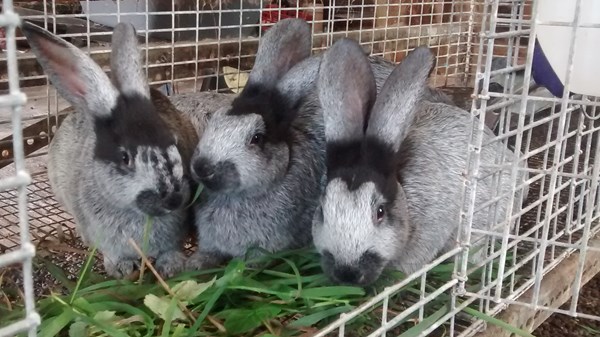
Did we miss something? Comment below with thoughts or questions about breeding meat rabbits…

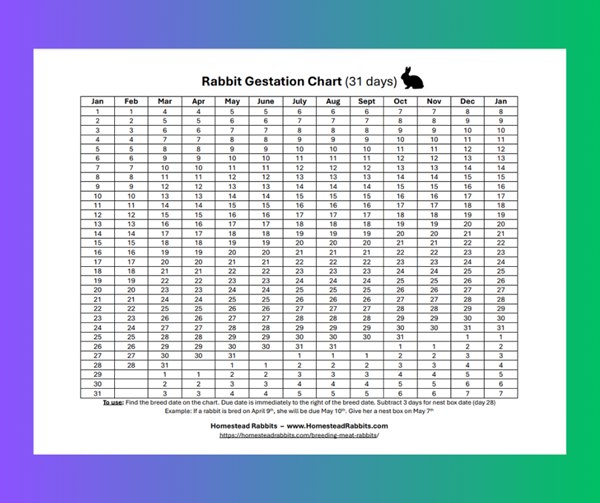
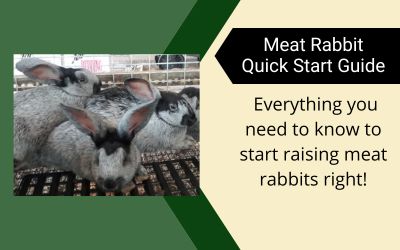

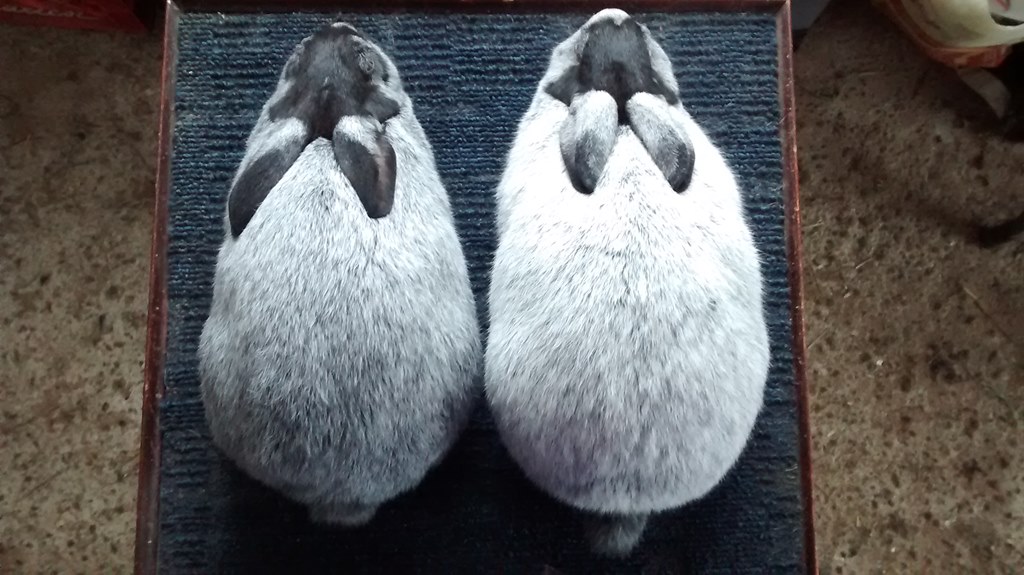

THANKS A BUNCH FOR ALL THIS INFORMATION. JUST STARTED RAISING RABBITS AND HAVE THE FIRST LITTER IN THE BOX MARCH 4th. NINE IN TOTAL. WHEEEE HERE WE GO.
Wow thank you! I’ll be near your location this summer. May I buy some rabbits from you to start with ?
Sure. We raise purebred Champagne d’Argent rabbits in central NY. We usually have litters available year-round. If desired, you can contact us to place some kits on hold a couple weeks before you come. Here’s my rabbitry website: https://bharabbitry.weebly.com/
Thank you this was very informative